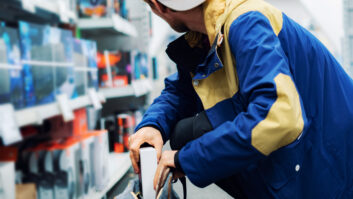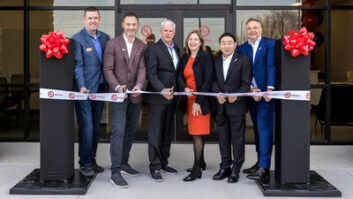For all it’s ferocity, the e-commerce contraction that has claimed the lives of CE pioneers etown.com, electronics.net, Everything For Less, Onsale.com and Value America-and has thrown the stock price and business plans of reigning e-tailers Amazon.com and Buy.com into a tizzy-should have come as no surprise.
As Jupiter Communications analyst Ken Cassar told TWICE two years ago, “There will certainly be a shakeout. Although the first ones in have the greatest opportunity, they also have the greatest risk. It may work for them, or it can all go up in smoke.”
Clearly, the hard lessons learned by the pure-play dot-coms and second-wave click & mortar contingent have been costly, but those still standing may ultimately grow stronger for the experience.
So what’s next for CE online? TWICE put that question to a roundtable of top e-tailers and multichannel chains during the 2001 Consumer Electronics Show in Las Vegas, including 800.com, Amazon.com, Best Buy, RadioShack and Ultimate Electronics, as well as analyst Jim Hirschberg, director of consumer electronics at market research group NPD Intelect. Highlights of that discussion follow.
TWICE:How significant a channel will the Internet ultimately prove to be for selling CE products?
CHRIS PAYNE: I’m very bullish.
[LAUGHTER]DAVE WORKMAN: You’re not going to tell us about the demise of the Internet or anything?
PAYNE: No, no, no.
DAVE EDMONDSON: Chris still thinks he’s going to take over the world.
PAYNE: No, no, no, no. Actually, channels can co-exist, they can complement one another, and I think they do.
We know through research that a lot of our customers come to our site, research products, and then go buy the product in the physical world. And that’s fine, because I think our brand gets the benefits of that as well. But I also want to sell products and do so profitably.
Who knows how big e-commerce is going to be in 10 or 20 years? Regardless of the number, the Internet is having a bigger impact on the industry overall. Not just measured by the sales that happen online, but in terms of educating the consumer.
I really think it is fueling a lot more sales in the marketplace today than we know because the consumer is using it as a tool. That’s going to get amplified as the physical-world retailers use the Internet to complement their channel. You do it today and you’re going to do it more. We welcome that at Amazon because we think that will encourage consumers to use the Internet more aggressively in making the right purchase decision for them.
FRANK SADOWSKI: Millions of shoppers have chosen the Internet to shop. We’re at a very key point in the evolution of shopping on the Internet because this past Christmas, if you read the evaluations, consumers overall were very happy with their purchases. They were very satisfied, unlike 1999.
So this is the crossover year for e-commerce, where it goes from being a novelty to being an accepted channel. Next Christmas the Internet will be just another place to shop. What is organic about the growth of the Internet is that it is self-evident to the consumer that the agenda is theirs.
JIM HIRSCHBERG: In terms of share of sale, the Internet as a channel for selling varies quite a bit more by consumer and by product category than any of the traditional retail channels. A lot of the CE categories in e-commerce are only two or three percent of business. But some are very, very dominant, like MP3, which is so closely associated with the ‘Net, with the younger consumer who is going to spend a lot of time on the Internet. There e-commerce accounts for better than 35 percent of sales.
So I think it’s a question like all the traditional channels-mass merchants have found their niche, specialty has found its niche, and e-commerce will find its niche as well.
TWICE:All of the brick & mortar retailers at this table now have e-commerce capabilities. What’syour take on e-tailing, and the importance of maintaining a click & brick presence?
MIKE LINTON: We’re finding that consumers are using our site a lot before they come in the store. Eighty percent of our consumers coming in the store are already online, and a lot of them are coming into the Best Buy site.
Our model is constructed off the non-commission model, and then to be completely channel agnostic. So what we’re seeing is a lot of leverage from what we think is a pretty good site, and the synergy between the store and the site, with the consumer finding the benefit of the information the way they want it. That seems to be working real well for us, and we’re getting a lot of good feedback on our site too.
TWICE:What’s the site’s share of total sales?
LINTON: We don’t think about it in terms of actual sales. We think about it in terms of benefit delivery. We look at sales across the brand, the Best Buy brand. And we believe that the site really helps the store and vice versa. It’s about managing the technology information. Whether that comes through people or electronically, we think the key is how you manage it and give it to the consumer when and how they want it. Because they don’t just want it all at one time in one place in one way.
So we think the site is really a vital piece to our strategy. I can’t tell you how the share of the sales split out. But we think it’s a really important piece in delivering the benefit that we’re about.
TWICE:Dave, RadioShack has been online for about two-and-a-half years now. What lessons have you learned?
EDMONDSON: Well, one of the things that we didn’t do was to go spend all of our money on trying to get from where we were to some virtual world. We didn’t really believe the hype that the world is going to come to an end, and that all business is going to transfer from format A to format B. We share with Best Buy the belief that the multichannel aspect of the business is a very important aspect of what the consumer wants. Everybody is not going to want just one thing.
So we thought our site through five phases. The first phase I’ll call brochure ware-you put up your fliers and your store locator, et cetera, et cetera.
Then you move into a phase that I call Wizard of Ozzycom. As incumbents, we have legacy systems that are in place. So you look like a commerce site that’s kind of like the Wizard of Oz, where Toto pulls open the curtain and the great Oz is behind there pulling all the knobs.
Then you begin to integrate the front end of your site into your back-end systems.
All these things take time, and they take money. They take a commitment to understanding where you want to go. Then Web-izing the store becomes a very important aspect. Last year we invested along with our partners millions and millions of dollars in bringing broad bandwidth into more than 4,800 stores across the country.
Lastly, you then look at how you integrate backwards into the supply chain so that you are in fact collapsing the time, energy and investment for both yourself and your partners who are supplying you
We really think of the Internet in those five dimensions. It’s not just about e-commerce. It’s not just about whether or not we’re going to transact. It’s about whether or not we’re going to create the right kind of experience for the customer as we leverage the power of information in the Web across our entire business.
TWICE:Both RadioShack and Best Buy are members of the WorldWide Retail Exchange, the B-to-B purchasing site. Have you realized any value from that yet?
EDMONDSON: It’s probably still early.
LINTON: It’s early. I think we’re relatively pleased with the start.
EDMONDSON: I would say the same thing. We’re pleased with the start, but it’s early.
TWICE:Are there any other compelling reasons to be online?
EDMONDSON: The Internet is an area that is not probably thought about as much within the retail format, but the ability of the associate on the floor to become the super navigator is something that we’re very excited about and that we’ve been putting our resources into.
Our ultimate vision is that our site will be robust enough in terms of content. You talk about surfing the Web, I think there are 5 billion pages on the Internet today. Truly, from a content standpoint the consumer does surf it-they go right across the top of it. If they go seven clicks deep, then they’ve really gone deep.
A real challenge from the Internet standpoint is a navigation tool that gets you off of surfing and into the robustness that we built. If you look at the number of individual pages that get hit vs. the number that you create, unfortunately, there’s a gap there. Figuring out how to get our people to be super navigators from the floor is an important long-term objective for us.
PAYNE: One of the advantages of the Internet channel is that you have one store that could service millions of consumers. In our case, today it’s over 25 million customers.
If you have a small group of great people, and you get it right on your website-you get the information right, you help customers discover the products they want to own, and you work with your manufacturing partner to get it right-you have consistency. The consumers can then come and get the information they need to make the right buying decision, and you don’t have to have thousands of salespeople to have consistency. You get it right once.
The great news is you can know when you don’t have it right because it’s not selling particularly well. It will show you whether you’re doing a good job or not.
SADOWSKI: The Internet is essentially being used by most people as a replication of an existing retail model-take a catalog and become an Internet catalog, take your Sunday insert and make it your home page.
What the Internet pure-play companies like Amazon and 800.com have done is to try and create a completely different environment, a completely different store, and personalization, customization and individualization of the experience is a big part of it.
It doesn’t have to be non-interactive. What most people are doing in the e-commerce portion of the Internet isn’t taking advantage of its inherent interactivity.
An Internet presentation of product is not necessarily an unassisted presentation of the product because we offer at 800.com live online chat on every single product page. We hire multiyear experienced consumer electronics salespeople exclusively for our product specialist group that’s on the other end of that chat. They will give you advice on a product, and they will e-mail you a transcript of the chat.
Also, there are many different kinds of customers. Some customers want to research a product for two weeks on their own on the Internet and in five different stores. To others, their time is much more important than their money, and they want to go to a retailer they can trust and get the advice.
My point is, don’t think that the Internet can’t do that. The Internet is ideally suited to do that, but e-commerce thus far has not taken advantage of its interactive capability as other areas of the Internet have. We intend to do that full force, and we’re doing it today.
WORKMAN: There are also products that are more experience-based-you know, a television set, a big-screen TV, a set of loudspeakers.
SADOWSKI: No question.
WORKMAN: They want to play with them. God bless consumers. They still want to put their hands on things.
It isn’t a one size fits all. I remember when the buying clubs first came out, and that was going to be the end of retail as we knew it. Every consumer was going to have a membership card and be buying everything that they own from these cost-plus-8 percent models. And then, of course, there were the national chains, and everybody was going to be wiped out when Best Buy and Circuit City marched across the land.
Every new iteration is always at least initially trumpeted as, “Oh, that’s the end of traditional retail.” And again we are just seeing that there is more segmentation, there are more answers, there are more products.













